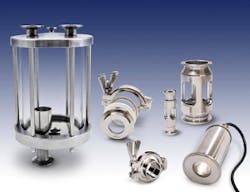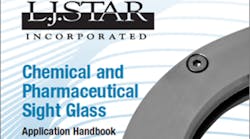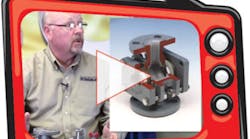Once you’ve decided you need a sight flow indicator, here are four steps to follow to simplify making the most appropriate choice.
Step 1: Choose the right style for your application. A tube-style flow indicatorpasses fluid through a glass cylinder that is visible from all angles, which allows ample ambient light to illuminate the flow. Although it’s ideal for checking a process fluid for clarity, color, foam, and the presence of moisture, it’s not appropriate for high pressures. A view-through flow indicator has two opposing windows that allow seeing the intervening flow of fluid lighted from behind, either by ambient light or with an attached luminaire. This design is suited for ANSI pressure classes, high temperature, and harsh fluid applications.
RELATED: Basics of Specifying the Correct Sight Flow Indicator
Step 2: Narrow down the specific function of the indicator. Various indicators can help observers gauge the direction and speed of flow of the process material. Flapper, rotary, drip, ball, and flutter indicators are all available for a variety of applications.
Step 3: Choose a mounting type. Indicators can be bolted, threaded, or attached with a sanitary clamp, which is a popular choice for pharmaceutical and food applications because they simplify cleaning.
Step 4: Determine the materials best suited to the application. A sight flow indicator is generally comprised of metal, gaskets, and glass. Although carbon steel and stainless steel are the two most common metals used, stainless steel offers better corrosion resistance. A Teflon coating is available for particularly aggressive process media. Be wary of low-cost castings that may result in problems down the road.
Gasket integrity is crucial to sight flow indicator performance. Gaskets are typically made of an enhanced PF material or teflon. Be sure that the gasket material used is compatible with the product with which it will come in contact.
Standard soda glass is typically used for low temperatures and non-corrosive products or cleaning solutions. For higher temperatures, use borosilicate glass because of its higher resistance to thermal shock, superior corrosion resistance, and higher temperature capabilities than soda lime glass. For very high temperatures, quartz or sapphire glass is recommended.
For more information on how to choose a sight flow indicator, download the “Step-by-Step Guide to Sight Glass Selection” white paper.
David G. Star is president and CEO of L.J. Star Incorporated, a supplier of sight glass and sight flow indicator products, and he is the owner of Tank Components Industries, a manufacturer of tank heads and related process vessel components.



